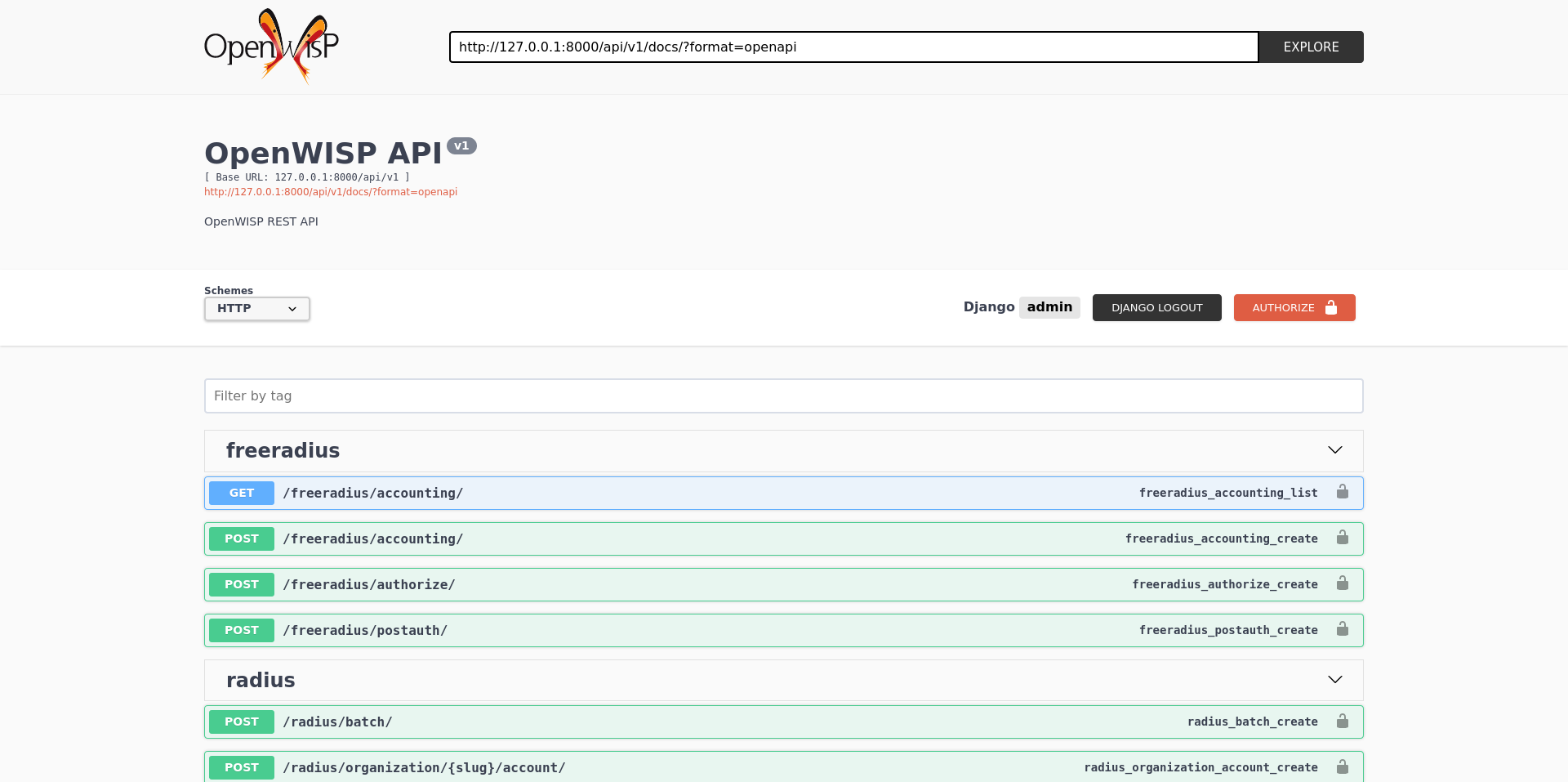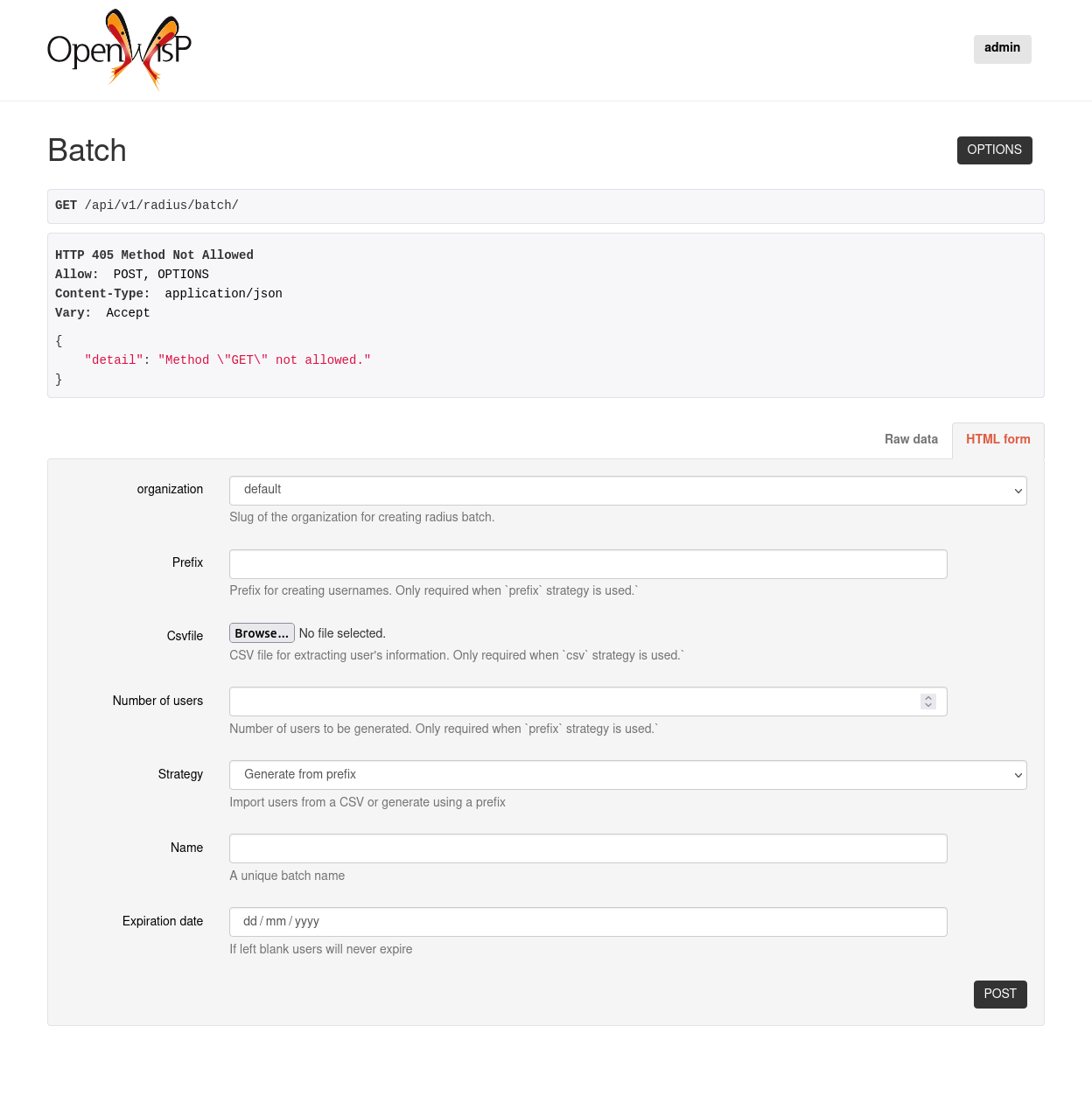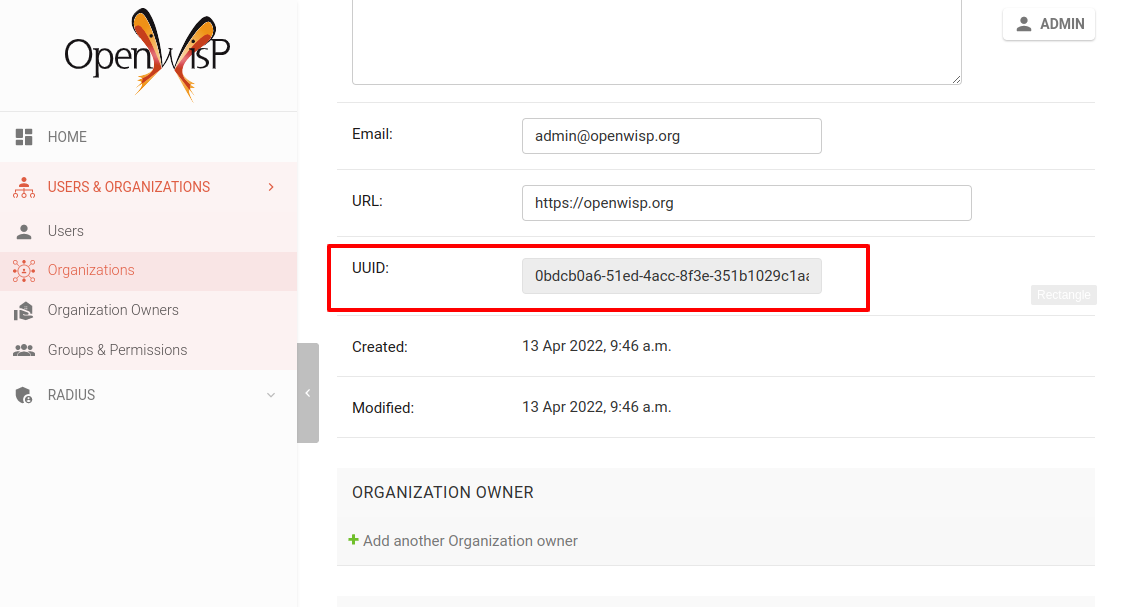REST API Reference
Important
The REST API of openwisp-radius is enabled by default and may be
turned off by setting OPENWISP_RADIUS_API
to False.
Live documentation

A general live API documentation (following the OpenAPI specification) at
/api/v1/docs/.
Browsable web interface

Additionally, opening any of the endpoints listed below directly in the browser will show the browsable API interface of Django-REST-Framework, which makes it even easier to find out the details of each endpoint.
FreeRADIUS API Endpoints
The following section is dedicated to API endpoints that are designed to be consumed by FreeRADIUS (Authorize, Post Auth, Accounting).
Important
These endpoints can be consumed only by hosts which have been added to the freeradius allowed hosts list.
FreeRADIUS API Authentication
There are 3 different methods with which the FreeRADIUS API endpoints can authenticate incoming requests and understand to which organization these requests belong.
Radius User Token
This method relies on the presence of a special token which was obtained by the user when authenticating via the Obtain Auth Token View, this means the user would have to log in through something like a web form first.
The flow works as follows:
the user enters credentials in a login form belonging to a specific organization and submits, the credentials are then sent to the Obtain Auth Token View;
if credentials are correct, a radius user token associated to the user and organization is created and returned in the response;
the login page or app must then initiate the HTTP request to the web server of the captive portal, (the URL of the form action of the default captive login page) using the radius user token as password, example:
curl -X POST http://captive.projcect.com:8005/index.php?zone=myorg \
-d "auth_user=<username>&auth_pass=<radius_token>"
This method is recommended if you are using multiple organizations in the same OpenWISP instance.
Note
By default, <radius_token> is valid for authentication for one
request only and a new <radius_token> needs to be obtained
for each request. However, if
OPENWISP_RADIUS_DISPOSABLE_RADIUS_USER_TOKEN is set to False,
the <radius_token> is valid for authentication as long as
freeradius accounting Stop request is not sent or the token is not
deleted.
Warning
If you are using Radius User token method, keep in mind that one user account can only authenticate with one organization at a time, i.e a single user account cannot consume services from multiple organizations simultaneously.
Bearer token
This other method allows to use the system without the need for a user to obtain a token first, the drawback is that one FreeRADIUS site has to be configured for each organization, the authorization credentials for the specific organization is sent in each request, see Configure the site for more information on the FreeRADIUS site configuration.
The (Organization UUID and Organization RADIUS token) are sent in the authorization header of the HTTP request in the form of a Bearer token, e.g.:
curl -X POST http://localhost:8000/api/v1/freeradius/authorize/ \
-H "Authorization: Bearer <org-uuid> <token>" \
-d "username=<username>&password=<password>"
This method is recommended if you are using only one organization and you have no need nor intention of adding more organizations in the future.
Querystring
This method is identical to the previous one, but the credentials are sent in querystring parameters, e.g.:
curl -X POST http://localhost:8000/api/v1/freeradius/authorize/?uuid=<org-uuid>&token=<token> \
-d "username=<username>&password=<password>"
This method is not recommended for production usage, it should be used for testing and debugging only (because webservers can include the querystring parameters in their logs).
Organization UUID & RADIUS API Token
You can get (and set) the value of the OpenWISP RADIUS API token in the
organization configuration page on the OpenWISP dashboard (select your
organization in /admin/openwisp_users/organization/):

Note
It is highly recommended that you use a hard to guess value, longer
than 15 characters containing both letters and numbers. E.g.:
165f9a790787fc38e5cc12c1640db2300648d9a2.
You will also need the UUID of your organization from the organization
change page (select your organization in
/admin/openwisp_users/organization/):

Requests authorizing with bearer-token or
querystring method must contain
organization UUID & token. If the tokens are missing or invalid, the
request will receive a 403 HTTP error.
For information on how to configure FreeRADIUS to send the bearer tokens, see Configure the site.
API Throttling
To override the default API throttling settings, add the following to your
settings.py file:
REST_FRAMEWORK = {
"DEFAULT_THROTTLE_CLASSES": [
"rest_framework.throttling.ScopedRateThrottle",
],
"DEFAULT_THROTTLE_RATES": {
# None by default
"authorize": None,
"postauth": None,
"accounting": None,
"obtain_auth_token": None,
"validate_auth_token": None,
"create_phone_token": None,
"phone_token_status": None,
"validate_phone_token": None,
# Relaxed throttling Policy
"others": "400/hour",
},
}
The rate descriptions used in DEFAULT_THROTTLE_RATES may include
second, minute, hour or day as the throttle period,
setting it to None will result in no throttling.
List of Endpoints
Post Auth
API endpoint designed to be used by FreeRADIUS postauth.
Responds only to POST.
/api/v1/freeradius/postauth/
Param |
Description |
|---|---|
username |
Username |
password |
Password (*) |
reply |
Radius reply received by freeradius |
called_station_id |
Called Station ID |
calling_station_id |
Calling Station ID |
(*): the password is stored only on unsuccessful authorizations.
Returns an empty response body in order to instruct FreeRADIUS to avoid processing the response body.
Accounting
/api/v1/freeradius/accounting/
GET
Returns a list of accounting objects
GET /api/v1/freeradius/accounting/
[
{
"called_station_id": "00-27-22-F3-FA-F1:hostname",
"nas_port_type": "Async",
"groupname": null,
"id": 1,
"realm": "",
"terminate_cause": "User_Request",
"nas_ip_address": "172.16.64.91",
"authentication": "RADIUS",
"stop_time": null,
"nas_port_id": "1",
"service_type": "Login-User",
"username": "admin",
"update_time": null,
"connection_info_stop": null,
"start_time": "2018-03-10T14:44:17.234035+01:00",
"output_octets": 1513075509,
"calling_station_id": "5c:7d:c1:72:a7:3b",
"input_octets": 9900909,
"interval": null,
"session_time": 261,
"session_id": "35000006",
"connection_info_start": null,
"framed_protocol": "test",
"framed_ip_address": "127.0.0.1",
"unique_id": "75058e50"
}
]
POST
Add or update accounting information (start, interim-update, stop); does not return any JSON response so that freeradius will avoid processing the response without generating warnings
Param |
Description |
|---|---|
session_id |
Session ID |
unique_id |
Accounting unique ID |
username |
Username |
groupname |
Group name |
realm |
Realm |
nas_ip_address |
NAS IP address |
nas_port_id |
NAS port ID |
nas_port_type |
NAS port type |
start_time |
Start time |
update_time |
Update time |
stop_time |
Stop time |
interval |
Interval |
session_time |
Session Time |
authentication |
Authentication |
connection_info_start |
Connection Info Start |
connection_info_stop |
Connection Info Stop |
input_octets |
Input Octets |
output_octets |
Output Octets |
called_station_id |
Called station ID |
calling_station_id |
Calling station ID |
terminate_cause |
Termination Cause |
service_type |
Service Type |
framed_protocol |
Framed protocol |
framed_ip_address |
framed IP address |
Pagination
Pagination is provided using a Link header pagination. Check here for more information about traversing with pagination.
{
....
....
link: <http://testserver/api/v1/freeradius/accounting/?page=2&page_size=1>; rel=\"next\",
<http://testserver/api/v1/freeradius/accounting/?page=3&page_size=1>; rel=\"last\"
....
....
}
Note
Default page size is 10, which can be overridden using the page_size parameter.
Filters
The JSON objects returned using the GET endpoint can be filtered/queried using specific parameters.
Filter Parameters |
Description |
|---|---|
username |
Username |
called_station_id |
Called Station ID |
calling_station_id |
Calling Station ID |
start_time |
Start time (greater or equal to) |
stop_time |
Stop time (less or equal to) |
is_open |
If stop_time is null |
User API Endpoints
These API endpoints are designed to be used by users (e.g.: creating an account, changing their password, obtaining access tokens, validating their phone number, etc.).
Note
The API endpoints described below do not require the Organization API Token described in the beginning of this document.
Some endpoints require the sending of the user API access token sent in the form of a "Bearer Token", example:
curl -H "Authorization: Bearer <user-token>" \
'http://localhost:8000/api/v1/radius/organization/default/account/session/'
List of Endpoints
User Registration
Important
This endpoint is enabled by default but can be disabled either via a global setting or from the admin interface.
/api/v1/radius/organization/<organization-slug>/account/
Responds only to POST.
Parameters:
Param |
Description |
|---|---|
username |
string |
phone_number |
string (*) |
string |
|
password1 |
string |
password2 |
string |
first_name |
string (**) |
last_name |
string (**) |
birth_date |
string (**) |
location |
string (**) |
method |
string (***) |
(*) phone_number is required only when the organization has enabled
SMS verification in its "Organization RADIUS Settings".
(**) first_name, last_name, birth_date and location are
optional fields which are disabled by default to make the registration
simple, but can be enabled through configuration.
(**) method must be one of the available
registration/verification methods; if identity verification
is disabled for a particular org, an empty string will be acceptable.
Registering to Multiple Organizations
An HTTP 409 response will be returned if an existing user tries to register on a URL of a different organization (because the account already exists). The response will contain a list of organizations with which the user has already registered to the system which may be shown to the user in the UI. E.g.:
{
"details": "A user like the one being registered already exists.",
"organizations":[
{"slug":"default","name":"default"}
]
}
The existing user can register with a new organization using the login endpoint. The user will also get membership of the new organization only if the organization has user registration enabled.
Reset password
This is the classic "password forgotten recovery feature" which sends a reset password token to the email of the user.
/api/v1/radius/organization/<organization-slug>/account/password/reset/
Responds only to POST.
Parameters:
Param |
Description |
|---|---|
input |
string that can be an email, phone_number or username. |
Confirm reset password
Allows users to confirm their reset password after having it requested via the Reset password endpoint.
/api/v1/radius/organization/<organization-slug>/account/password/reset/confirm/
Responds only to POST.
Parameters:
Param |
Description |
|---|---|
new_password1 |
string |
new_password2 |
string |
uid |
string |
token |
string |
Change password
Requires the user auth token (Bearer Token).
Allows users to change their password after using the Reset password endpoint.
/api/v1/radius/organization/<organization-slug>/account/password/change/
Responds only to POST.
Parameters:
Param |
Description |
|---|---|
current_password |
string |
new_password |
string |
confirm_password |
string |
Login (Obtain User Auth Token)
/api/v1/radius/organization/<organization-slug>/account/token/
Responds only to POST.
Returns:
radius_user_token: the user radius token, which can be used to authenticate the user in the captive portal by sending it in place of the user password (it will be passed to freeradius which in turn will send it to the authorize API endpoint which will recognize the token as the user password)key: the user API access token, which will be needed to authenticate the user to eventual subsequent API requests (e.g.: change password)is_activeif it'sfalseit means the user has been bannedis_verifiedwhen identity verification is enabled, it indicates whether the user has completed an indirect identity verification process like confirming their mobile phone numbermethodregistration/verification method used by the user to register, e.g.:mobile_phone,social_login, etc.usernameemailphone_numberfirst_namelast_namebirth_datelocation
If the user account is inactive or unverified the endpoint will send the data anyway but using the HTTP status code 401, this way consumers can recognize these users and trigger the appropriate response needed (e.g.: reject them or initiate account verification).
If an existing user account tries to authenticate to an organization of which they're not member of, then they would be automatically added as members (if registration is enabled for that org). Please refer to "Registering to Multiple Organizations".
This endpoint updates the user language preference field according to the
Accept-Language HTTP header.
Parameters:
Param |
Description |
|---|---|
username |
string |
password |
string |
Validate user auth token
Used to check whether the auth token of a user is valid or not.
Return also the radius user token and username in the response.
/api/v1/radius/organization/<organization-slug>/account/token/validate/
Responds only to POST.
Parameters:
Param |
Description |
|---|---|
token |
the rest auth token to validate |
The user information is returned in the response (similarly to Obtain User Auth Token), along with the following additional parameter:
response_code: string indicating whether the result is successful or not, to be used for translation.
This endpoint updates the user language preference field according to the
Accept-Language HTTP header.
User Radius Sessions
Requires the user auth token (Bearer Token).
Returns the radius sessions of the logged-in user and the organization specified in the URL.
/api/v1/radius/organization/<organization-slug>/account/session/
Responds only to GET.
User Radius Usage
Requires the user auth token (Bearer Token).
Returns the radius usage of the logged-in user and the organization specified in the URL.
It executes the relevant RADIUS counters and returns information that shows how much time and/or traffic the user has consumed.
/api/v1/radius/organization/<organization-slug>/account/usage/
Responds only to GET.
Create SMS token
Note
This API endpoint will work only if the organization has enabled SMS verification.
Requires the user auth token (Bearer Token).
Used for SMS verification, sends a code via SMS to the phone number of the user.
/api/v1/radius/organization/<organization-slug>/account/phone/token/
Responds only to POST.
No parameters required.
Get active SMS token status
Note
This API endpoint will work only if the organization has enabled SMS verification.
Requires the user auth token (Bearer Token).
Used for SMS verification, allows checking whether an active SMS token was already requested for the mobile phone number of the logged in account.
/api/v1/radius/organization/<organization-slug>/account/phone/token/active/
Responds only to GET.
No parameters required.
Verify/Validate SMS token
Note
This API endpoint will work only if the organization has enabled SMS verification.
Requires the user auth token (Bearer Token).
Used for SMS verification, allows users to validate the code they receive via SMS.
/api/v1/radius/organization/<organization-slug>/account/phone/verify/
Responds only to POST.
Parameters:
Param |
Description |
|---|---|
code |
string |
Change phone number
Note
This API endpoint will work only if the organization has enabled SMS verification.
Requires the user auth token (Bearer Token).
Allows users to change their phone number, will flag the user as inactive and send them a verification code via SMS. The phone number of the user is updated only after this verification code has been validated.
/api/v1/radius/organization/<organization-slug>/account/phone/change/
Responds only to POST.
Parameters:
Param |
Description |
|---|---|
phone_number |
string |
Batch user creation
This API endpoint allows to use the features described in Importing users and Generating users.
/api/v1/radius/batch/
Note
This API endpoint allows to use the features described in Importing users and Generating users.
Responds only to POST, used to save a RadiusBatch instance.
It is possible to generate the users of the RadiusBatch with two
different strategies: csv or prefix.
The csv method needs the following parameters:
Param |
Description |
|---|---|
name |
Name of the operation |
strategy |
csv |
csvfile |
file with the users |
expiration_date |
date of expiration of the users |
organization_slug |
slug of organization of the users |
These others are for the prefix method:
Param |
Description |
|---|---|
name |
name of the operation |
strategy |
prefix |
prefix |
prefix for the generation of users |
number_of_users |
number of users |
expiration_date |
date of expiration of the users |
organization_slug |
slug of organization of the users |
When using this strategy, in the response you can find the field
user_credentials containing the list of users created (example:
[['username', 'password'], ['sample_user', 'BBuOb5sN']]) and the field
pdf_link which can be used to download a PDF file containing the user
credentials.
Batch CSV Download
/api/v1/radius/organization/<organization-slug>/batch/<id>/csv/<filename>
Responds only to GET.
Parameters:
Param |
Description |
|---|---|
slug |
string |
id |
string |
filename |
string |